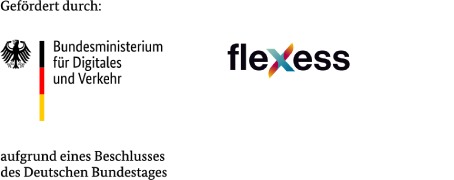Home Knowledge station Electromobility in the company flexess: Energy transition through electromobility
In the course of the energy transition, the energy sector is undergoing a comprehensive transformation through the integration of renewable energies into the electricity system. In order to ensure the success of the transition to renewable energies in the areas of electricity, heat and mobility, efficient flexibility in the feed-in and withdrawal of electrical power plays a decisive role. The flexess project partners worked together to develop and implement solutions for a flexible and sustainable energy supply.



The household case study was dedicated to researching the potential for flexibility in existing single-family and multi-family homes as well as in new buildings. Possible flexibility measures include the use of photovoltaic systems, battery storage and heat pumps in conjunction with local energy management.
In the commercial, retail and services sector, the focus was particularly on the potential of existing air-conditioning systems in supermarkets and other chain stores to exploit flexibility.
The industrial sector also offers considerable potential for flexibility due to its high energy requirements and the extensive control options for processes and machines. The use of revenues from in-house generation and the possibility of storage can create additional economic incentives to exploit flexibility potential.
The electromobility case study specifically addressed the potential of flexibility in the context of potential applications for vehicle fleets, such as use as flexible energy storage.
The potential analysis shows a cross-sectoral potential for energy flexibilization of approx. 25 GW / 35 TWh/a. Depending on the scenario, this could amount to approx. 20-40 GW / 27-53 TWh/a in 2030. The regulatory framework conditions and economic incentives were also taken into account here.
Period
July 2019 until December 2022
Destination
Development of solutions for exploiting flexibility potentials in the electricity, heat and mobility transition, as recommendations for action for the energy industry
Result
Identification of savings potentials and framework conditions
In this study, the theoretical flexibility potential through the use of electric vehicles in combination with charging stations (AC, DC) was analyzed.
The number of electric vehicles in Germany is currently growing exponentially, albeit at a comparatively low level. Due to the legal framework, the supply of electric vehicles and charging points as well as customer demand, this growth trend is expected to continue in the future. It therefore makes a lot of sense to include the potential of energy flexibilization through the integration of electric vehicles into the energy system.
For all vehicle classes, a strong increase in both the absolute number of electric vehicles and the relative share of all registered vehicles is expected in the future. The share of electric vehicles in new car registrations is expected to be between 35% and 76% in 2030.


We will be happy to support you at any time – from a no-obligation initial consultation to expert support, on the phone, in person or online.

On our blog you will find helpful and interesting advice articles on the most important topics for managing your fleet.

In our webinars, we inform you about the Carano product world and impart knowledge about successful fleet management.
Subscribe to the Carano newsletter now and receive the latest news from the fleet industry directly in your mailbox! Please note that the newsletter is only available in German.
"*" indicates required fields
Products
Industries
Knowledge Station
Company